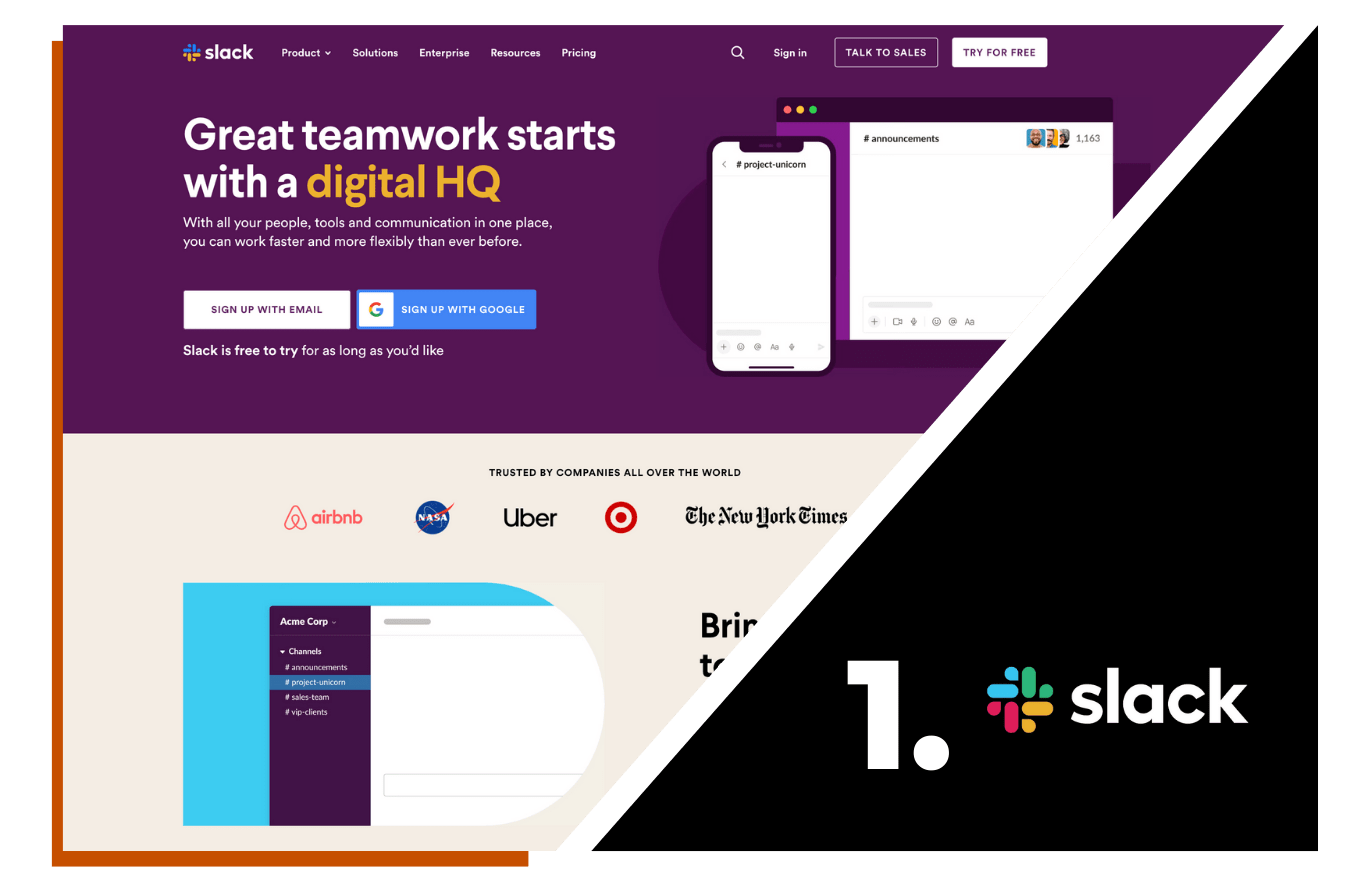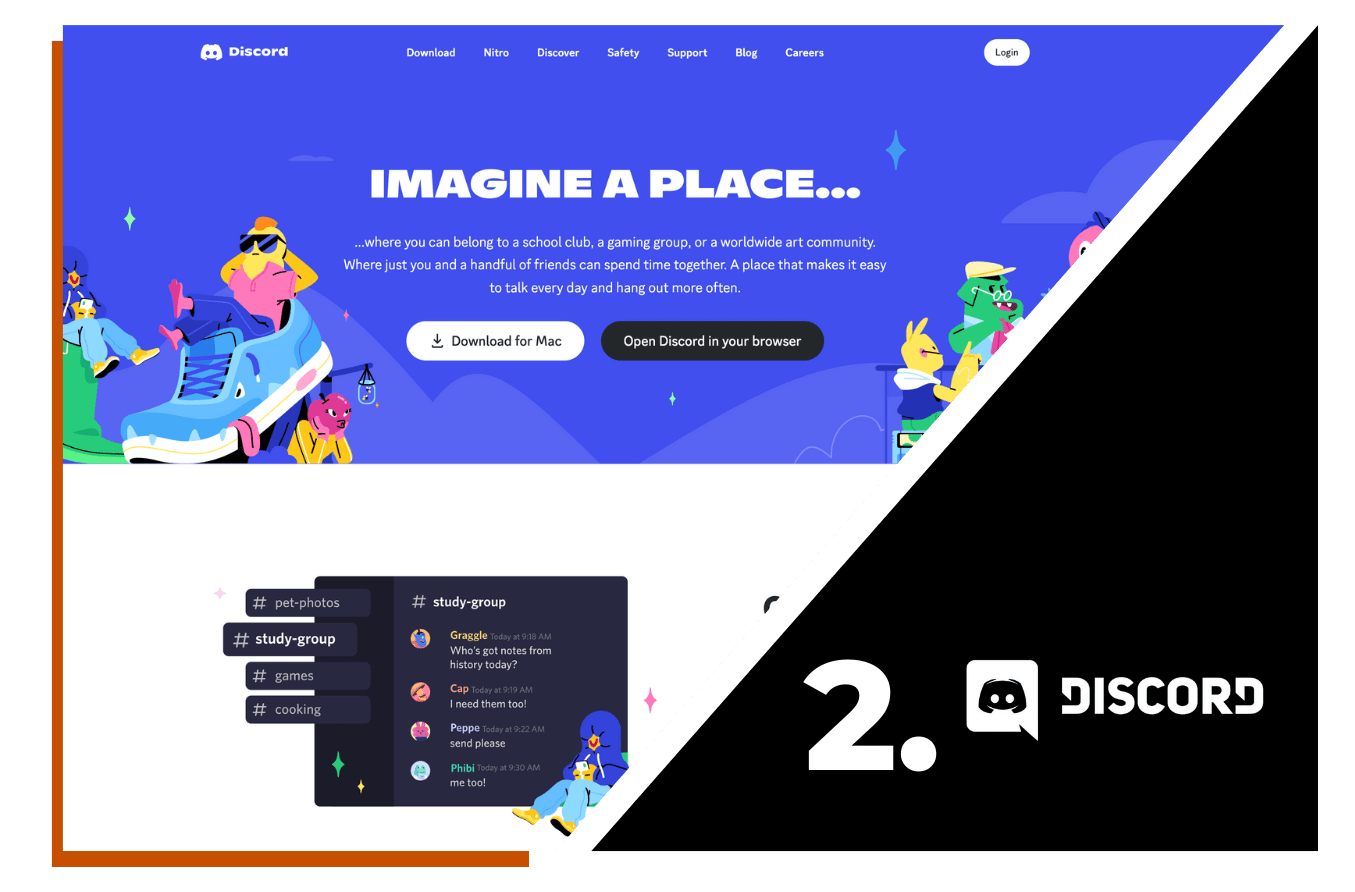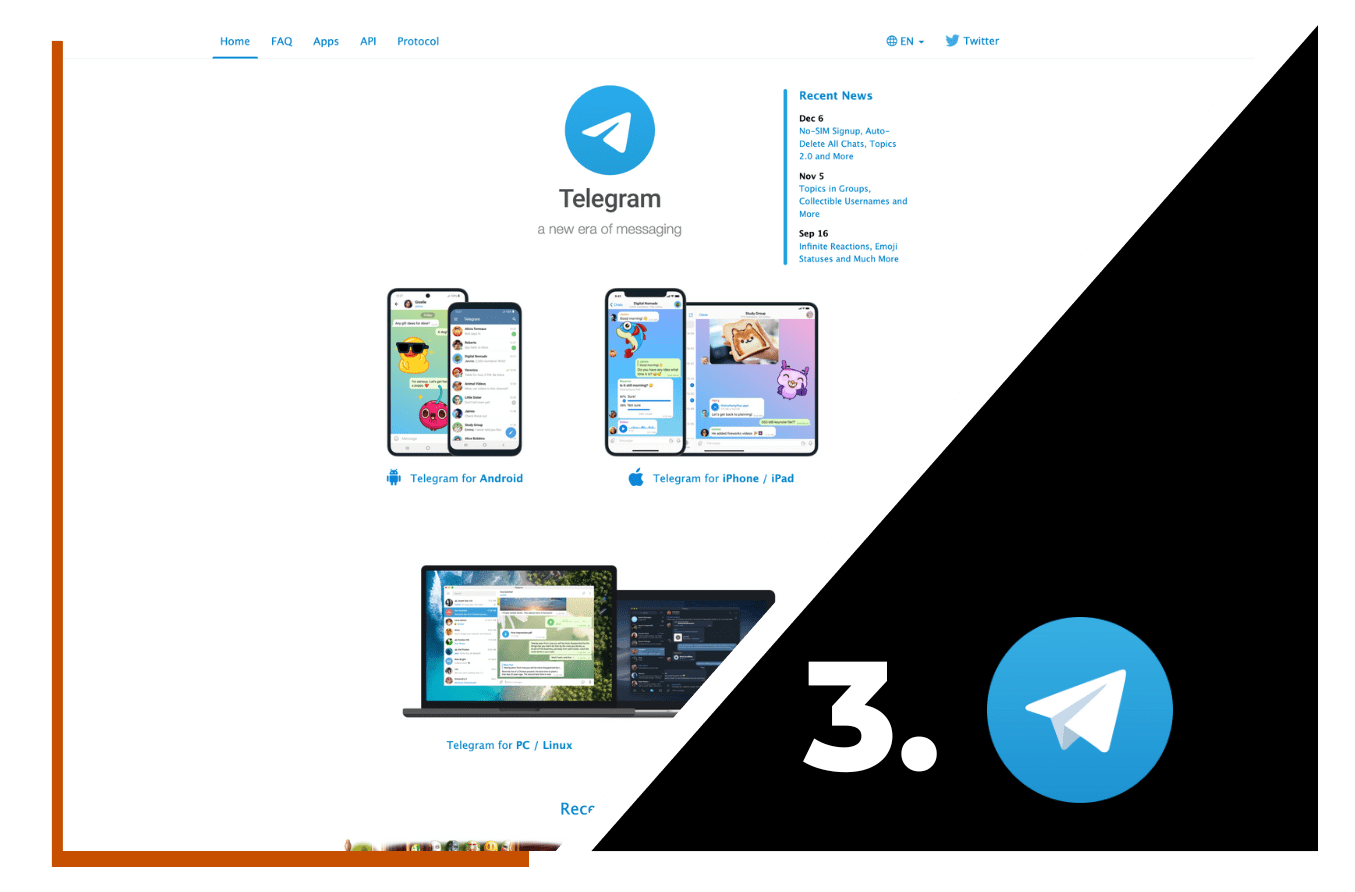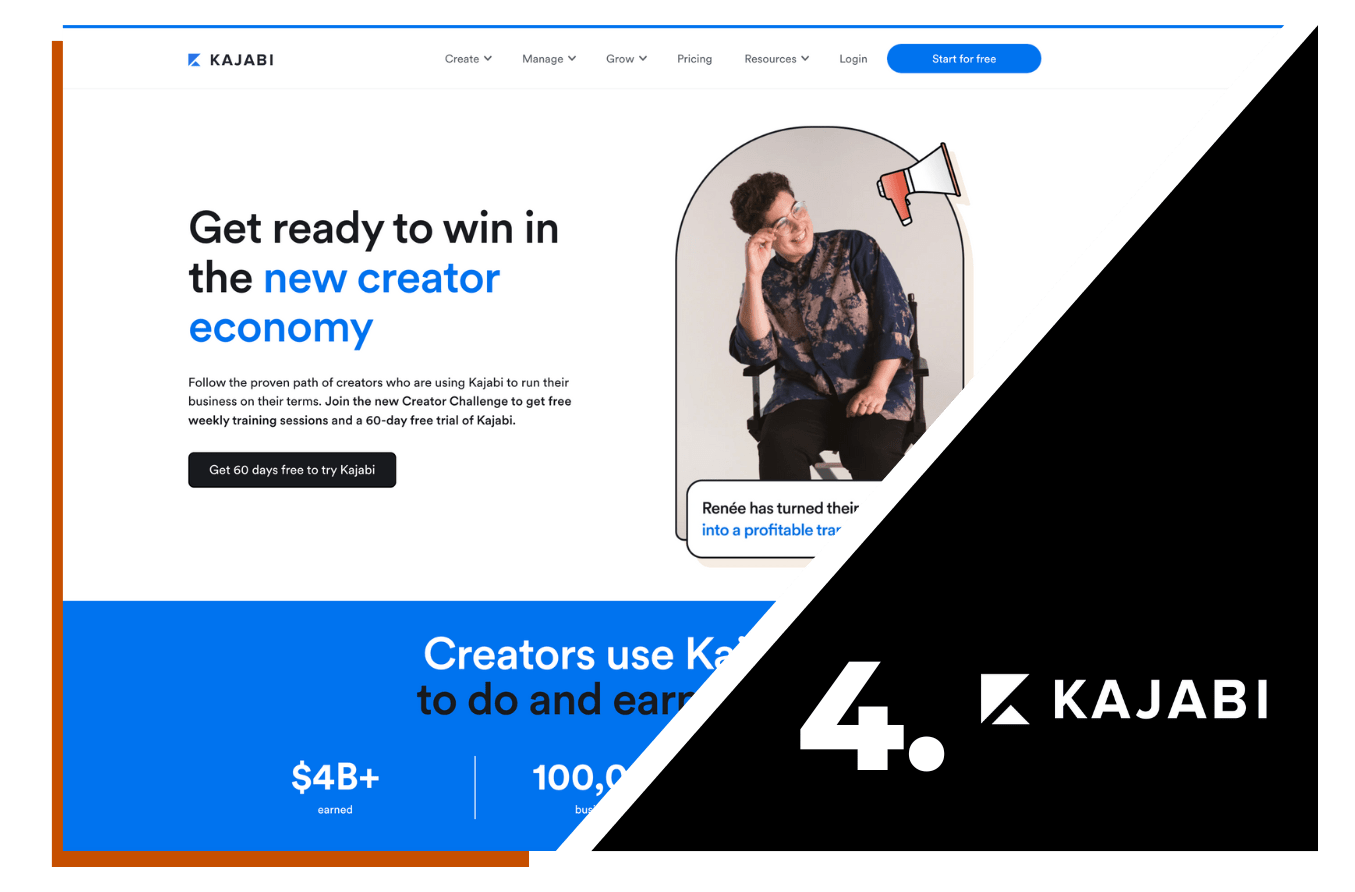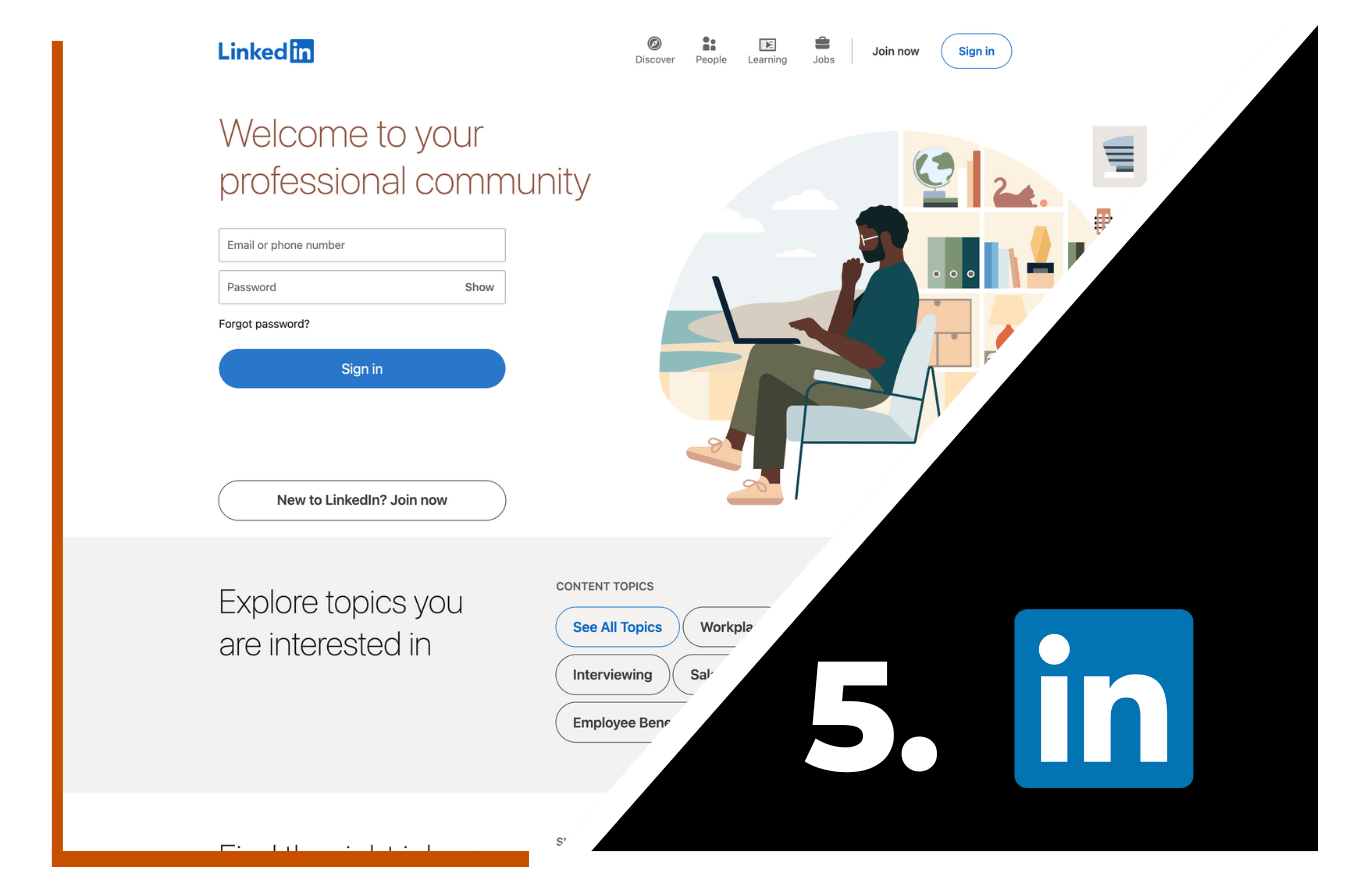What is Digital Engagement?
5 Awesome Alternatives to Facebook Groups
- Community
- Framework
- Guiding People
- and 4 more...

Over the years, many have relied on Facebook Groups to launch or grow an online community – and it used to be for a good reason. They were easy to start up and got you connected to millions around the globe, with a clean look and a place-to-be atmosphere. But that was then. Now, alternatives to Facebook groups are on the rise.
These days, more and more are turning away from Facebook Groups, with everything from the lack of monetization tools to scandals in the news driving the shift. If you run an online community, it may be time to consider some alternatives to Facebook Groups – and luckily, there are many options to choose from.
From customizable branding and greater control over what your members see, to positive associations with the platform and the ability to launch courses, there are many reasons to switch. Learn how you can manage groups on a platform you control.
Here are 5 powerful alternatives to Facebook Groups that will help your community thrive.
1. Slack
If you work in an office setting, you might already be familiar with Slack. It’s a business productivity tool best known for its chat function, helping team members stay in touch whether they work in person or remotely. But, its group-building tools are top notch, too.
Key attributes:
- Popular system, easy to learn
- Private communication channels
- Scale with your needs
Drawbacks:
- No monetization
- Not great for project management natively
2. Discord
Likewise, Discord is another growing alternative to Facebook Groups with a great messaging system. You can set up groups and separate conversations into text and voice chat channels, and it’s also available on both mobile devices and web browsers. Plus, it’s pretty user friendly.
Key attributes:
- Easy to set up and great interface
- Free to use
- Live chat rooms
Drawbacks:
- Text and voice chat only, no custom branding
- Limited free features
3. Telegram
If you already have a Facebook Group, but are looking for alternatives to Facebook Groups, Telegram might be a fairly smooth transition. It’s a social media platform that can be used on almost any kind of device, can be monetized, and has a built-in user base. But it has been described as confusing to use.
Key attributes:
- Social-media based – easy transition from Facebook Groups
- Can be monetized
- Large groups
Drawbacks:
- Confusing to use and requires frequent optimization
- Security
4. Kajabi
Kajabi is a community builder well suited to hosting online courses, if that’s your thing. You can also create custom branding, making it one of the standout alternatives to Facebook Groups – but all that power comes with a literal price. Plus, it’s more difficult to set up.
Key attributes:
- Ideal for online courses
- Customized branding
- Professional website
Drawbacks:
- Can be costly to run, and tough to learn
- Not great for physical product sales
5. LinkedIn
Most people know and trust LinkedIn as a social network tool for professionals and job seekers, but few realize it also features a Group function similar to Facebook Groups. It’s fairly basic but easy to set up, and comes with big time community-growth potential.
Key attributes:
- Trusted by more than 800 million users in 200 countries
- Good ease of use and sharing functions
- Large groups, easy to manage and communicate with members
Drawbacks:
- No monetization
- Can be costly to access full feature sets
All of these alternatives to Facebook Groups offer ways to create a unique experience on an alternative platform, and each one has its own area of strength. But if you’re looking for the total package – ease of use, custom branding, the ability to monetize or host online courses, and control over what’s allowed and what’s not in your own group, look no further than Cause Machine. Our platform is purpose-built to grow impact-making online communities; schedule your free demo today.
Get Started With Cause Machine
Starting with a community engagement strategy is the secret to building a successful platform in the long term. Cause Machine helps customers build the plan of engaging a community well and then begin mapping out the technology to help support that strategy. We’re certain that you’ll find some great resources and powerful tools in Cause Machine to better engage your community. Learn how it can work for you here.
5 Best Association Management Software Platforms
- Community
- Marketing
- Technology
- and 1 more...

The vast majority of associations are run by fewer than ten people – small teams who already rely on, or could benefit from, association management software. The truth is that each one of those associations requires a lot of hands-on administration, even if it's small. That administration is expensive and time-consuming and is basically a time suck for the few employees a small association has.
Despite that, it's still vital work – and association management software aims to help.
What Makes Association Management Software Different from Other Software?
A quality association management software platform can do everything from building a website to running a member database. They can automate email communications, payment collections, donations, event management, and make sure all the financial requirements of running an association are met. In short, they can free your team up to do the things that associations are really meant to do.
The problem lies in choosing the right association management software for your association, but we can help. Culled from hundreds of association management software options, here are five of the best.
The Five Best Association Management Software Platforms Right Now
1. Cause Machine
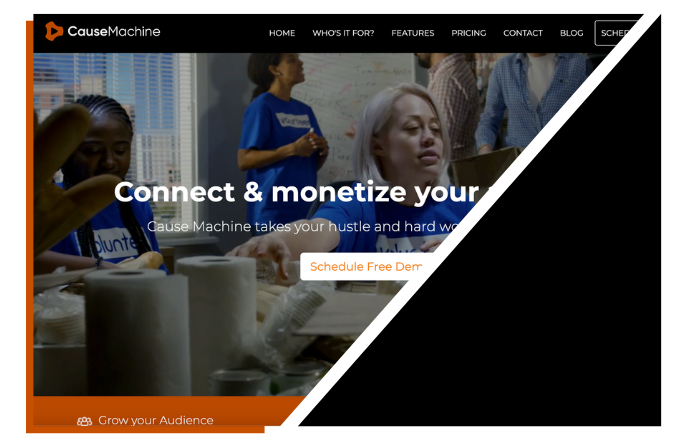
Up until now, we've introduced association management software options that are useful in a variety of situations – but Cause Machine is something different. The most versatile option by far, Cause Machine is an infinitely customizable platform that can meet all the needs of an association – large, small, or in between.
Building a cost-effective and practical web platform to manage your association is key for scalability and experience. You can even create members-only areas with added benefits too. Cause Machine can supercharge communications, help maintain the day-to-day, and even streamline association events. Cause Machine starts by defining your objectives and helps you build the platform to meet your organizational needs.
Great features include:
- Tailored software for specific association needs
- Drag and drop web builder
- Free trial and dedicated support
- Event management
- Email marketing tools
- eCommerce, membership billing, managed tiers, and more
- Dynamic CMS
- Job Board
- Launch Mobile Apps
- Free trial available
Especially for the thousands of small associations that need a practical association management tool, getting off the treadmill of hands-on administration is as easy as trying out the right association management software.
Get a tailored solution to your organization's needs. Schedule a free demo with Cause Machine to get back to doing what your association is really meant to do.
2. WildApricot
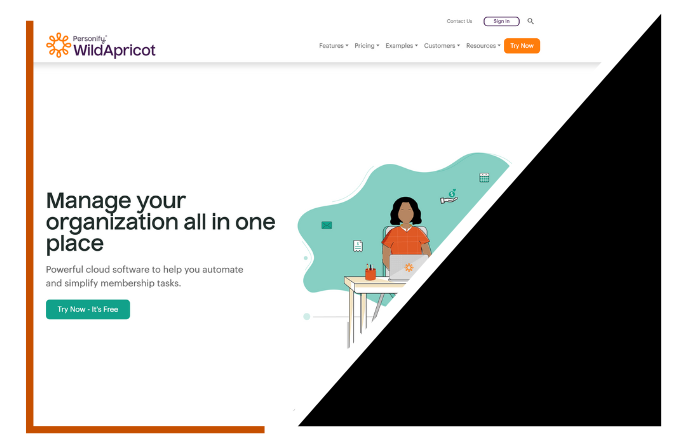
\WildApricot has steadily become one of the most visible association management software platforms, and that's because it comes with many of the features associations need. From a (basic) website builder to a built-in email system and a mobile app, it can be helpful to organizations of all sizes – and comes with a free trial period.
Great features include:
- Build websites and member directories
- Event Management
- Automate payments and renewals
- Free 60-day trial
3. GrowthZone
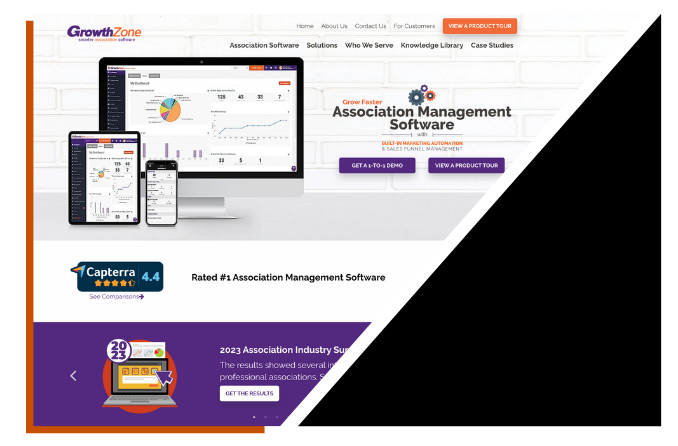
GrowthZone is an association management software option that is focused on what its name implies – growth! The basic plan includes everything that others do as well – including member management tools, financial tools, and the like – but it can be scaled up with marketing solutions and added "modules" as your organization grows, which is ultimately the whole point, right?
Great features include:
- Website builder with member and event management tools
- Marketing tools and sales funnel
- Payment processing
- Free demos and monthly payment plans
4. MemberLeap
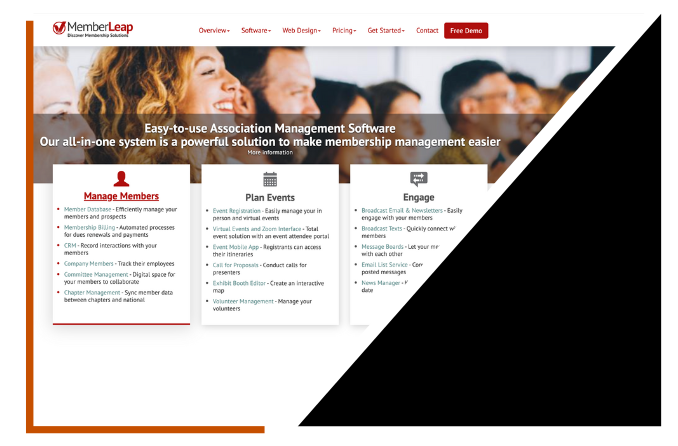
MemberLeap is an example of powerful association management software that is tailored for one specific segment of the association landscape. Along with all the basic functions of member and financial management, it features a convenient integration with QuickBooks. With 26.5 million businesses using QuickBooks in the US, that could be very useful!
Great features include:
- Member database with plans
- Integrates with QuickBooks for accounting
- CRM system
- Starts at $50/month, plus website setup packages from $1,800+
5.SilkStart
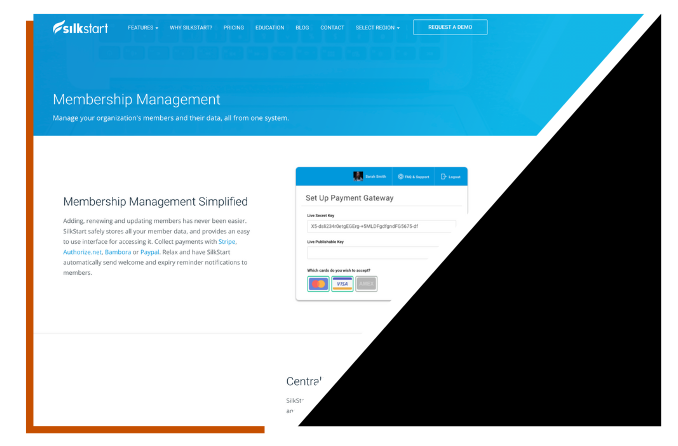
With SilkStart, small associations can get everything they need – and the "smooth" transition they hope for. This software is designed to be simple and easy to use for administrators, and its features are designed to get the job done. Features include job boards, donation pages, chapter integration, and mobile-friendly websites.
Great features include:
- Simple tools for website, members-boards, donations, and more
- Event management
- Job board
- Email Marketing
Get Started With Cause Machine
Starting with a community engagement strategy is the secret to building a successful organization in the long term. Cause Machine helps organizations build the plan of engaging a community well and then begin mapping out the technology to help support that strategy. We're certain that you'll find some great resources and powerful tools in Cause Machine to better engage your community. Learn how it can work for you here.
Creating Your Digital Engagement Ecosystem

An ecosystem can be defined as a “biological community of interacting organisms and their physical environment”. This is fascinating to think about… a sophisticated interactive grouping of both elements and their environments. Truth is, we all live in multiple ecosystems… families, work, education, friendships, local municipalities, governments, and so much more. But what we’re talking about here is the idea of a digital engagement ecosystem?
So I would define a digital engagement ecosystem as your collection of digital engagement points with your community. These engagement points and tools should all be considered part of one larger system. They do not stand alone. Your social media strategy should not be isolated from your blog strategy and so forth. The tighter you integrate your digital elements, the stronger each one of them becomes. So what are some examples of elements that fall into our digital ecosystem? Here’s a start. This isn’t comprehensive as you will certainly have others and technology is constantly changing.
-
Social Media - this is probably the most obvious and known element in a digital engagement strategy. We see most groups having social media accounts but primarily lacking good strategy in this area and especially lacking integration between social and all the other efforts.
-
Website - websites are still the foundation of how most everyone presents their digital persona and storefront. These serve as great tools to educate and introduce yourself to the world.
-
Mobile App - some organizations and initiatives have dedicated mobile apps to drive a specific strategy or business function. Mobile apps are best designed when a single app serves the purpose of a specific user experience or function.
-
Email - yes, email. Email seems to get the rap of the dark ages it seems but there are still great strategies for email engagement and the engagement data can still be really solid when done well.
-
Virtual Events - these could be webinars to full-scale virtual conferences. These serve to bring people together at a specific point in time to learn and be equipped.
-
eCouress - these deliver on-demand training and are equipped for people as they are searching for being equipped in something specific. These are more point-in-time engagements but still great for equipping.
-
Community Platform - these are private login and membership access sites where your community can privately connect in your controlled environment to better bond your tribe together.
These are just a few examples of what could be in your digital engagement ecosystem. Your task is to explore which fit your engagement strategy best. Here are some tips.
-
Dream Big + Act Small - dream big about all the things you could do in the world of digital engagement to build your ecosystem… but focus on acting small. Don’t tackle all of this at the same time. Have a roadmap for where you would like to be but don’t start by trying to do it all at the same time.
-
Prioritize - run through your list of potential engagement pathways and force yourself to prioritize them in sequential order. That will help you allocate time and financial resources as you continue to build your engagement strategies.
-
Natural Fits - look for the engagement pathways that make the most sense for your business strategy. What are your people asking for and what would resonate best with them? Meet them where they are vs. trying to force new habits on them.
-
Be Creative - these are only a few examples of engagement tools but there are so many more. Be creative and add others that fit your strategy and meet your audience well where they are.
And the last tip… once you do have a good idea of what fits into your digital engagement ecosystem, build a visual that you can share with your team. These are helpful for you to solidify your ecosystem and also to help communicate to your team.
Have fun!
Cause Machine Solutions
The Cause Machine platform creates a primary environment for your digital engagement ecosystem providing website solutions, e-courses, virtual events, email sending, memberships, and more. The entire platform of Cause Machine is designed to facilitate your digital engagement ecosystem. Schedule a demo today!
How to create and sell online courses: 8 questions to answer right now.
 by Will Rogers
by Will Rogers

When it comes to knowing how to create and sell online courses, it’s tough to know where to start, what to do, when to do it, and in what priority. I get these questions often. They go something like, “I think what I know is useful to people. But, I have no idea how to create and sell a course online. How in the world would I get started doing that?”
What follows is my attempt to explain what I’d tell you are the steps you need to complete. If I was sitting with you having coffee, I’d map these things out with you. In fact, go ahead, grab a cup of coffee and let’s dive in.
Question #1 Course objectives: what will your course help people do?
When you’re considering your course objectives, this is a perfect time to think through the goals of your course. For example:
- What’s the defining WIN? How do you define success? How will you know you’ve succeeded when you’re “done”? I know, you’re never done. But, it’s worth thinking about and defining it at this stage!
- What’s the value proposition? Write it down at this stage.
- What does the person get (on the other side) of signing up? List everything out—no bad idea at this stage. You’ll hone this list down at a later stage.
Answering these questions at this stage will set you on the right path going forward.
Question #2 Course structure: how will you break up the content so people will use it?
I know, you’re content is great. Everyone will buy it and finish every single minute! Wrong! You will need to consider how you will break up your content in pieces that are digestible for your followers. Consider a few options:
- Break up content into a few sessions? This may be the most simple way.
- Break into modules bundled together? Consider how your sessions might fit into modules.
- Take as you please? Maybe you don’t need an order for your content—and the buyer will decide?
- Time-spaced release? You post only a few things—and drop the rest of the content on a rhythm?
- Unlocked sessions after another session? For content that needs to be finished in order, consider this approach.
Question #3 Course style: how will you teach so people will listen?
This is an important question. It doesn’t matter how great your content is or how well you break it up and deliver it, if you don’t get this part right—it can hurt your success. Consider a few options:
- Voice-over slide deck? This option is the lowest on the tech need but can work for some content that needs a ton of examples.
- Full-on camera? This option is a bit techier—but typically worth the time.
- Team recorded? Will take more time and logistics, and more tech. But, it’s often worth it to get others in on the play—it helps your followers digest the content too.
- Zoom recorded? This will take a bit more tech knowledge, but it’s doable and can help you in getting started.
- Combo or hybrid? Maybe you do several of these options.
While deciding this really depends on your comfort factor and content, deciding the style of your course early on will prove vital and help you answer future questions on this list.
Question #4 Course delivery: how will people get your information?
Answering this question will take some thought. Depending on your content, what’s the best vehicle for launching your course? Here are a few examples I’ve seen work:
- Sign up as you please: this is usually done with a strong website and will take planning. This typically involves a hybrid of web, email, or even a membership site to accomplish.
- Cohort structure: maybe your content fits this style of taking a few people at a time through your course.
Question #5 Course personalization: how will you make people feel welcomed?
Another vital question is to think past the point of purchase. What will happen after a follower signs up? Consider a few things:
- Welcome communications: will you send a series of emails? What will be in those emails?
- Personal call or messaging: this will take a lot of time. But, the relational dot-connecting when you’re starting out can be invaluable.
- Welcome kits: will you create a kit that helps folks feel welcome? How will you deliver it?
Question #6 Course tools: what will you offer to help people learn?
Answering this question depends on the content you’re offering and how your followers may want to digest it. Consider a variety of options. The more the better!
- Workbooks: provide guides that house reference content and can be used as the follower is walking through your course.
- eBooks: be sure to have content you can use in bite-size chunks to deliver and encourage your followers.
- Worksheets: is there some of your content that would fit this format? Adding as many varieties as possible to your course will aid the learner at this stage.
Question #7 Course price point: what will you charge people who want it?
This may be one of the toughest questions to get right. Trust me, answering this question will feel like shooting in the dark. Here are some ideas that have helped me and others answer this question:
- Think 10x the value of your price point. Having this in mind will shape the entire course and your thinking about it.
- Under $100 for a key lesson type course. If you’re considering a topic-by-topic approach, this pricing may be in bounds.
- Over $500 for a full framework type course. If you’re going to cover several topics by the time someone finishes your course, this pricing may help you as you think through the timing of your course from start to finish.
Question #8 Course marketing: how will you promote what you're doing?
Once you’ve created your course and answered the previous seven questions, guess what, you’re not done! You’re just at the starting point! It’s now time to market your course. Consider a few ideas for how you might promote your course:
- Sample content: give a portion of your content away for free so followers will see it.
- Course outline: provide followers with an outline of all you will cover in your course from start to finish.
- Course objectives: spell out what you hope followers will learn from the course.
These are the eight questions I’d ask you if I was having coffee with you in person. Answering these questions will help you get your head around the why, who, what, when, where, and how of creating and selling your online course. My guess is, if you’re reading this, you have a great idea and want to help people. It’s time to ask yourself these eight questions. I look forward to seeing where your answers take you.
 Need more help taking your community digital?
Need more help taking your community digital?
You want to have a dynamic and multi-dimensional community that thrives. In order to do that, you need a strategy of both online and offline engagement. This guide will help you think through your approach to engaging a virtual community. Download the free eBook: How to Take Your Community Digital.
About the author: Will Rogers is the Founder and CEO of CauseMachine. Will’s career has been spent leading organizations and helping to mobilize communities to a shared vision. He has served in various leadership roles to build community engagement and movements teaching him valuable hands-on skills and experience. Will has developed business and community engagement strategies for dozens of organizations in nearly 50 countries. He and his wife have two sons and now live in Kentucky after two decades in Colorado.
13 Non Profit Blogs Worth Following

The non-profit sector is a huge and vital part of the economy. Doing serious work on serious issues, nonprofits help underpin what we think of as a civil society, often tackling the issues that private businesses or government agencies can't.
Unfortunately, trust in institutions continues to fall, making it harder than ever to run a non-profit – just when we seem to need them most. Luckily, there are many non-profit blogs out there that share tips and generally help organizations do their best, and even the average, caring person can benefit from reading.
What is a Non-Profit?
This might sound like a silly question, but it's worth defining. A non-profit organization is operated for "collective, public, or social benefit" as opposed to a business aiming to generate a profit for its owners. Any money taken in is used to run the organization and pursue its goals, and as such, nonprofits are accountable to their donors, team members, beneficiaries, and the public at large.
What Kind of Impact Do Non-Profits Make?
A pretty big one. According to the most recent Health of the U.S. Non-Profit Sector quarterly review (released in January 2023), there are 1.8 million nonprofits in the U.S., and combined, they contributed $1.5 trillion to the economy in just the third quarter of 2022. Their "gross value added makes up 5.6% of Gross Domestic Product," a figure which is outpacing the U.S. GDP growth as a whole.
A Zippia research study says nonprofit revenue has grown at almost 8 percent annually since 2000. But, involvement in the sector is in decline. The number of U.S. volunteers declined by 19 percent from 2019-2021, and donors decreased by 7 percent in the second quarter of 2022 compared to the year-ago period.
13 Nonprofit Blogs to Follow Now
Stay up to date with industry news, react to trends, and get the most out of your own nonprofit in a challenging environment. You might even have a little fun, and those looking in from the outside? You might find yourself inspired to help reverse the downward trend.
1. Chronicle of Philanthropy
The Chronicle of Philanthropy can help nonprofits and average citizens alike stay up to date on industry news.
2. The Nonprofit Times
Using a paid model, The Nonprofit Times reports breaking nonprofit news and offers in-depth industry. It's a full-on newspaper dedicated to the nonprofit space.
3. The Fundraising Authority
If you're running a nonprofit, think of The Fundraising Authority as customer support. They are dedicated to helping nonprofits get better at raising money, communicating, and impacting their mission.
4. The Storytelling Nonprofit
This one is great because of the pictures! Run by nonprofit pro Vanessa Chase Lockshin, the blog is built on short posts with lots of videos, often told in story form. It's a refreshing option.
5. Charity Navigator
If you are looking to donate or partner, Charity Navigator can help evaluate the decision. But it also covers legal issues and offers paid content like online training.
6. Double the Donation
As the name implies, this nonprofit blog is focused on maximizing revenue by patterning organizations with corporate partners willing to match donations.
7. Get Fully Funded
Through easy-to-read content, Get Fully Funded helps nonprofits understand the complexities of getting and managing funds without running afoul of the law (or going broke).'
8. Bloomerang
Those in need of help engaging the public and then managing the results can find it at Bloomerang, along with advice geared especially toward smaller operations.
9. Nonprofit AF
Nonprofit expert Vu Le writes this blog, which covers all kinds of ways to improve the function of any nonprofit. Fundraising, executive board management, finance, etc.
10. Nonprofit Talent
The mid-Atlantic region is a hotbed for nonprofit activity, and this blog functions as a job board and recruiting site for local talent.
11. Stanford Social Innovation Review
The SSIR is a well-known magazine and website covering big problems and solutions. All with a global reach and top-level experts.
12. TechSoup
Many nonprofits can be optimized with the right tech solutions, and TechSoup helps make that happen – both with advice and by actually selling discounted technology.
13. GuideStar
Finally, GuideStar is like the Google of nonprofit blogs, so if you don't know where to look for a specific topic, just check here. Over 250 categories are included.
The U.S. nonprofit sector is huge and plays an important role in society, but despite growing revenue, involvement is down, and many other challenges remain.
Get Started With Cause Machine
Starting with a community engagement strategy is the secret to building a successful platform in the long term. Cause Machine helps customers build the plan of engaging a community well and then begin mapping out the technology to help support that strategy. We’re certain that you’ll find some great resources and powerful tools in Cause Machine to better engage your community. Learn how it can work for you here.

